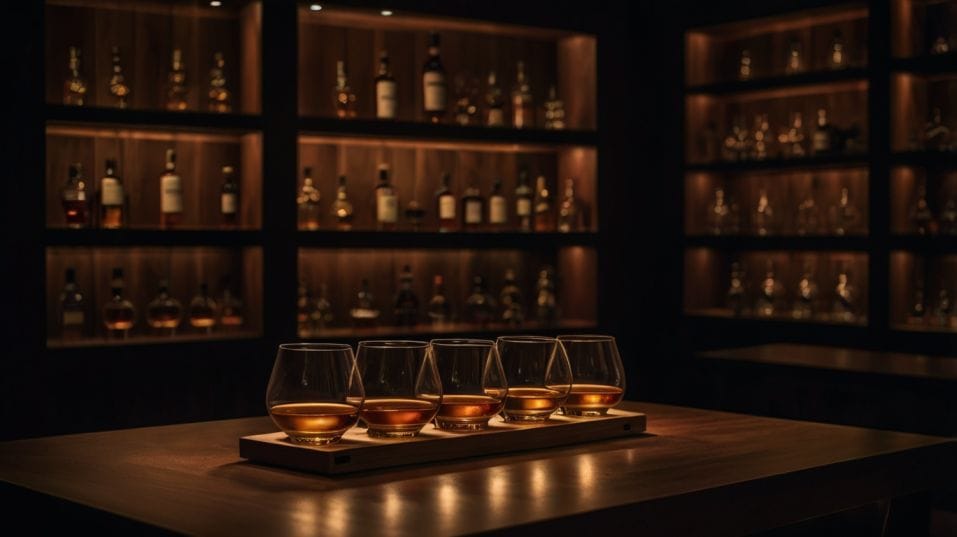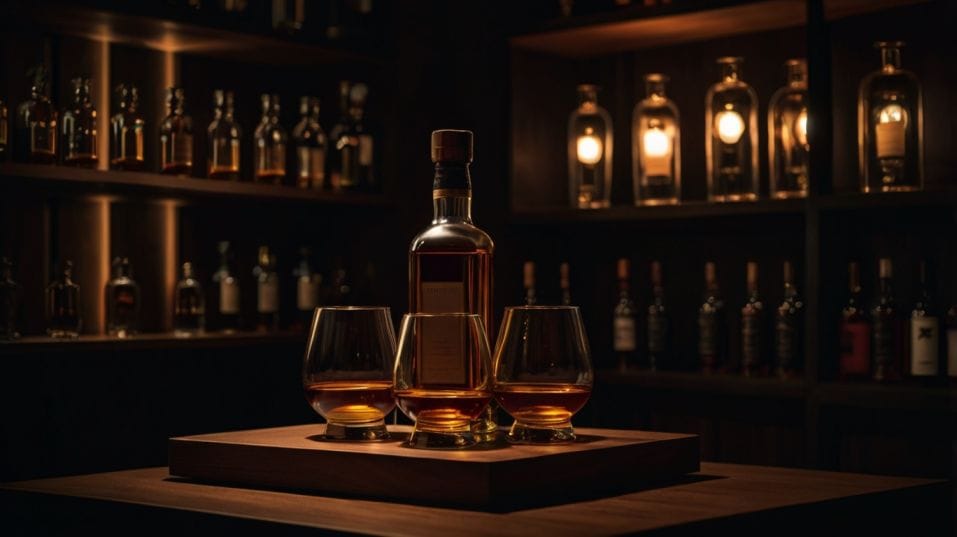Building a Minimalist Whiskey Bar at Home
Build a whiskey bar that sharpens your palate, not clutters your shelf. Learn how to taste, select, and grow with clarity and confidence.

What if your whiskey shelf actually made you better at tasting? Not bigger. Not flashier. Just sharper.
If you're past the hype and hunting something deeper—something that actually trains your palate—you’re ready to build a minimalist whiskey bar.
One with fewer bottles, clearer purpose, and more flavor. This is about learning, not collecting. Drinking with attention, not abundance. A bar that works as hard as you do to understand what’s in the glass.
Purpose Before Bottles
A minimalist whiskey bar starts with a clear question: what’s it for? Not for entertaining guests. Not for showing off your rare finds. Not for mimicking a hotel lounge. Your bar is for learning, tasting, refining.
It’s for understanding whiskey at a level where the label matters less than the liquid. Every bottle should either push your palate forward or reinforce what you already know.
Think in terms of contrast and range. A high-rye bourbon teaches spice. A peated Scotch challenges your comfort zone.
A rich, sherried single malt anchors your sense of sweetness. You don’t need every region represented—you need bottles that talk to each other. That’s how you start to notice difference, depth, and detail.
Build slowly. Repetition matters. The second, third, tenth pour of the same whiskey reveals things the first couldn’t.
Familiarity doesn’t dull your palate—it sharpens it. You start to catch the subtleties. You learn what lingers, what fades, what evolves. That’s how your taste memory gets built.

Selecting the Right Bottles
There’s no universal list of “starter whiskeys.” The right choices depend on your current palate and what you want to explore next. But a few guiding principles keep you out of the weeds:
Choose structure over hype
Look for well-made whiskey with clear flavor architecture—grain-forward, balanced wood influence, deliberate proof. Avoid celebrity brands, marketing stunts, and limited editions with no reputation.
Use proof as a tool
Bottles in the 100–115 proof range often offer the best balance between flavor density and drinkability. Cask strength can be enlightening, but it demands attention and often water.
Think across production styles
A mix of bourbon, rye, malt, grain, and blends gives you a broad vocabulary. You don’t need five bourbons—you need one that shows corn sweetness, one that leans spicy, one that plays with oak. Let each bottle teach a different lesson.
Let go of FOMO
You don’t need a dusty shelf of “just in case” bottles. If something’s not worth drinking now, it’s not worth keeping. Whiskey isn’t art—it’s meant to be opened, poured, and understood.
The Tools That Make It Work
You don’t need a drawer full of accessories. Just the ones that pull their weight.
Glassware
A tulip-shaped glass like the Glencairn is essential. It traps aroma, guides your nose, and concentrates flavor. Rocks glasses are fine for social pours, but they’re blunt instruments for real tasting.
A dropper
Add a few drops of water to higher-proof whiskey and watch the whole thing open up. It’s not about “watering it down”—it’s about unlocking hidden structure. Water lowers alcohol volatility, making subtler aromas accessible.
Notebook or app
Taste memory fades. Notes help you remember not just what you tasted, but what mattered. Skip generic terms like “smooth” or “bold.” Focus on what changed—on the nose, on the palate, in the finish.
A solid base surface
Whether it’s a bar shelf, a small cabinet, or just a clean corner of your kitchen, give your bottles a space that signals purpose. This isn’t a liquor cabinet. It’s a studio.
Storage That Respects the Whiskey
Whiskey isn’t fragile like wine, but it does need care. Heat, light, and air are the enemies.
Keep bottles upright. Whiskey dissolves cork over time if it stays in contact. Store them away from direct sunlight. UV light fades labels and degrades flavor slowly but surely. A cool, dark cabinet is more protective than any display case.
If you keep open bottles for more than six months, start paying attention to fill levels. More air in the bottle means more oxidation.
The flavors won’t spoil overnight, but they will flatten. If a bottle’s getting low, finish it. Or decant the remainder into a smaller container to reduce air exposure.
How to Actually Taste
Tasting is a skill. Not an act. Not a ritual. It’s attention, applied.
Pour a half-ounce. Let it sit for a few minutes. Smell it without swirling. That first nosing gives the clearest read. After that, your nose starts adapting. Then swirl gently. Smell again. Note what changed.
Sip slowly. Hold it for a few seconds. Focus on structure. Does it hit all at once or build? Is the sweetness upfront or in the finish? Where’s the burn, if any? How long does the flavor linger?
Then wait. Come back to it. Some whiskeys evolve over time in the glass. Others don’t. That contrast matters.
You’re not chasing poetic tasting notes. You’re building a memory bank. What oak influence feels like. What rye does to your tongue. What short finishes sound like in your mouth. The more you notice, the more fluent you get.
Curating Your Collection Over Time
A minimalist bar evolves. Bottles come in, bottles go out. Nothing sits untouched for a year.
Curate based on what deepens your palate. If you’ve learned everything a whiskey has to offer, don’t replace it with a slightly older sibling. Move sideways. Try a different cask finish, grain bill, or region. Chase flavor structure, not brand names.
Be ruthless. If a bottle underdelivers, move on. Keep your shelf lean. Keep it working. Let curiosity guide you—but don’t confuse novelty with value.
And when something truly speaks to you—buy a backup, sure. But open it. Drink it. Explore it while it’s fresh in your mind.
Final Thoughts
Building a minimalist whiskey bar is about clarity. It’s about giving yourself the best environment to taste deeply, learn freely, and drink with purpose.
It’s not for hoarding. It’s not for flexing. It’s not for chasing what’s scarce. It’s for developing taste. Real taste.
Start with what you have. Pour a whiskey you think you know. Taste it like you don’t. Pay attention to what it teaches you. Then ask: what do I need next—not to collect more, but to understand more?
That’s the bar you’re building. So build it. Taste something tonight that pushes your palate forward. Make the shelf matter. Let the whiskey speak.




